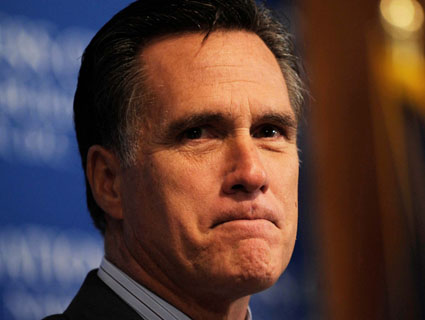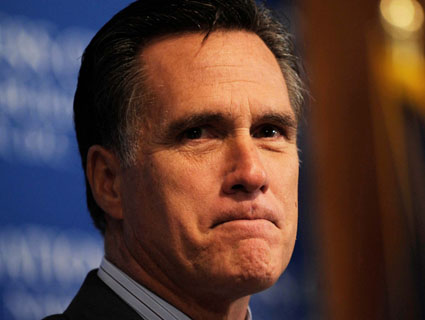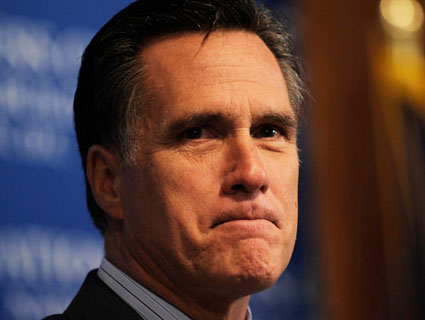
Christy Bowe/Zuma
When Mitt Romney’s presidential campaign announced a less-than-expected $18 million fundraising haul for the second quarter of this year, Democrats and Republicans alike publicly doubted the former governor’s appeal with GOP voters. Some of Romney’s critics even suggested that donors had “abandoned him.” But judging Romney’s cash arsenal by his campaign alone is like looking at a Jackson Pollock canvas from an inch away. You need to step back to see the whole picture—in Romney’s case, a sprawling web of organizations with serious financial firepower angling to help Romney win in 2012.
Romney’s biggest outside ally is Restore Our Future, a so-called “super PAC” launched last month by a trio of his former aides. The PAC’s goal is simple: make Mitt Romney president. And while federal law prohibits Restore Our Future from coordinating with the Romney campaign, the PAC can raise and spend unlimited amounts of money on ads, mailers, and other messaging to boost Romney’s White House bid. It’s not unlike the Priorities USA Action super PAC that two former Barack Obama aides formed with the goal of reelecting the president.
Created in October, Restore Our Future’s roster boasts one of Washington’s savviest Republican strategists in Carl Forti, who’s worked for Karl Rove’s American Crossroads groups, the conservative dark money outfit Americans for Job Security, and the 60 Plus Association, known as the conservative answer to the AARP. Charlie Spies, a former CFO and counsel from Romney’s 2008 campaign, is also on board. (Neither Spies nor Forti would comment for this story.)
Last week Spies emailed reporters to say that Restore Our Future, which reports its donors and fundraising haul twice a year, had raked in $12 million in the first six months of 2011. (The group has yet to file its official report.) Spies added that the group has $12 million in cash on hand, an indicator of just how little money it takes to operate a super PAC. Adding the Restore our Future money to the official campaign money brings the amount raised explicitly to elect Romney to $30 million.
Then there is Romney’s network of Free and Strong America PACs. The federal Free and Strong PAC, headquartered in Boston, raised $1.9 million in the first quarter of 2011 and another $9.1 million in the 2010 election cycle. Complete 2011 data isn’t available for the Free and Strong America state PACs in Alabama, Iowa, Michigan, New Hampshire, and South Carolina, but they did reel in $1.6 million in 2010—nearly five times as much as state PACs tied to fellow GOP contender Tim Pawlenty.
As a presidential candidate, Romney can’t coordinate with his Free and Strong America armada. But there’s an obvious political calculus behind running state-level PACs in presidential battleground states: It allows a candidate to court state-level allies well before the candidate himself announces a run. That’s exactly what Romney’s PACs did. According to the National Institute on Money in State Politics, Romney-affiliated PACs gave nearly $400,000 in campaign contributions in 25 different states in 2009 and 2010. That included $62,000 to then-gubernatorial candidate Nikki Haley in South Carolina and $30,000 to then-gubernatorial candidate Terry Branstad in Iowa (some of which went to Branstad’s running mate, Kim Reynolds). Both Haley and Branstad won their elections, potentially giving Romney powerful partners for his second White House run.
But more importantly, these state PACs have allowed Romney to lay the groundwork for his presidential run while skirting federal campaign limits. In Alabama, Michigan, and Iowa, individual donors can give unlimited amounts of money to PACs. (By contrast, federal law caps total donations to national PACs at $5,000.) While PACs like those in Romney’s Free and Strong network supposedly exist to support other candidates, only 25 percent of 2010 spending by Romney’s Free and Strong America state PACs actually went to candidates, and just 21 percent of the national PAC’s 2011 haul went to candidates. The rest of the funds almost certainly went to overhead—staff salaries, travel, events, and building supporter lists that could prove crucial in a presidential race. “Major candidates including Romney are declaring their candidacy later and later, into May and some cases into June” the year before the presidential election, says Paul Ryan, an attorney at the Campaign Legal Center. “The reason they delayed their announcements is because they wanted to raise more unlimited money through state-level vehicles.” (A Romney spokesman did not respond to a request for comment.)
Romney’s expansive fundraising and spending machine may dwarf those of the other 2012 Republican candidates, but he didn’t originate the strategy—Ronald Reagan did. After failing to win the GOP nomination in the 1976 election, Reagan took his leftover funds and started Citizens for the Republic PAC, a separate fundraising operation ostensibly created to help other GOP candidates. The group actually centered on Reagan himself, and the PAC would ultimately bring in $5 million in donations and amass a list of 300,000 active donors, according to Colby College political-science professor Anthony Corrado. The PAC also paid for consultants, volunteer drives, and pro-Reagan events—all paving the way, experts say, for Reagan’s 1980 presidential victory. And here’s the kicker: By not calling Citizens for the Republic a presidential committee, Reagan dodged the campaign donation laws of that era.
So can Romney follow Reagan’s path to the White House? Campaign finance experts say that Romney has capitalized on state PACs and weak fundraising regulations more than any other GOP candidate. And they caution that, before drawing too many conclusions from the Romney campaign’s somewhat lackluster second-quarter fundraising numbers, it’s important to look at all the money marshaled in the candidate’s favor. “Hands down, no one is even close to Romney on this,” says Michael Beckel, a reporter at the nonpartisan Center for Responsive Politics, which tracks the flow of money in American politics. “These groups amount to an unlimited bank account to push a message that supports him.”

















